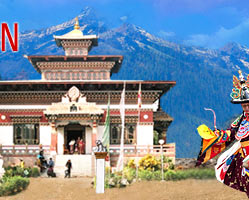Perched on a steep ridge which rises from the confluence of the two rivers, Dongdi chu and Kholong chu, the Trashiyangtse Dzong was sanctified with the sacred rabney (consecration) ceremony on March 23 and 24, 2005. His Holiness the Je Khenpo and monks performed the Tagoen (preparatory rite) and the Ngezhi Sungchog and conducted the Zhewai Jinseg (fire-offering) the next day. This was followed by the Tashi Tendrel (circumambulation of the monument) by dzongkhag officials, representatives of the dratshang and the people of Trashiyangtse. The ceremony concluded with the Tashi Moenlam.
Besides renovating the Dzong a new Kuenra, (the main hall for religious activities) adorned with Kuten and Sungten (sacred images and scriptures), a Neypoi phodrang (shrine for local deity), two shabkors (monks living quarters) with 12 rooms each, a courtyard, pavement, drainage system and approach road were constructed at the cost of about Nu. 10 million, funded by the government. The construction work began in 2001.
One of the most revered and oldest monasteries in eastern Bhutan, the Trashiyangtse Dzong was originally called Dongdi Dzong. Historical accounts suggest that a palace or dzong of some kind was built on the present site as far back as the ninth century by Gongkar Gyalpo, grandson of Lhasey Tsangma. According to the principal of Trashiyangtse Institute for Zorig Chusum, Lam Kezang, who conducted research on Trashiyangtse dzong, Terton Pema Lingpa (the treasure revealer) built the dzong in the 15th century on the same site where Dongdi dzong stood.
Lam Kezang said that the dzong was built by Gongkar Gyalpo but a Tibetan invasion made the people of Donglum flee and the dzong fell into ruins. Terton Pema Lingpa not only built the dzong but also named it Trashiyangtse which means that it has sufficient space on steep terrain.
The main statue (nangten tsowo) for the three-storied dzong is a Chuchizhe (Avalokiteshvara with 11 faces) at the top floor. Legend has it that the statue was discovered by an old woman who lived near the dzong.
According to oral history, news of the Chuchizhe statue spread as far as Bumthang. The chieftain of Bumthang took the statue there but unusual weather conditions made the atmosphere in the valley bad and sickness prevailed. There were bad omens. The chieftain turned to the Zhabdrung to explain what caused all those mishaps.
The Zhabdrung said that something new had been brought and kept on the altar. The chieftain confessed about the Chuchizhe and immediately returned it to Dongdi dzong.
The dzong is also famous for its sacred scriptures, Sungten Kanjur, which has 100 volumes with the first page of each volume printed in gold. According to Lam Kezang a man from Udzorong had killed a citizen of Yangtse Byekhar and the chieftain of Yangtse demanded compensation from the chieftain of Udzorong.
Since they could not pay a compensation in cash or kind, the Yangtse chieftain demanded that 111 volumes of Kanjur housed at the Gephu lhakhang be given to Yangtse. The 100 volumes were reported to be handed over. The holy scripts are considered valuable and are recited at least once a year.
The dzong also has a Terphur (treasure dagger) and a "Dam Lung" (subduing boulder) presented by Terton Pema Lingpa. Oral accounts state that a demon in Dongdi chu was causing great harm to the people. The Terton threw a boulder at the devil and subdued it.
Today, the same boulder can be seen on the wall at the main entrance in the ground floor of the dzong.




